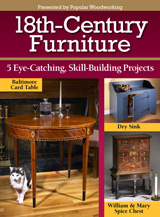We may receive a commission when you use our affiliate links. However, this does not impact our recommendations.
 One question to ask of any style is whether it can stand the test of time. Leather motorcycle jacket? Sure. Red satin disco jacket? No.
One question to ask of any style is whether it can stand the test of time. Leather motorcycle jacket? Sure. Red satin disco jacket? No.
This holds true with furniture. When it comes to woodworking, 18th-century furniture is perennially popular. Many 18th-century pieces are like the leather motorcycle jacket; they’re stylish, but serve a practical purpose. A spice chest will build your joinery skills, but the multiple drawers – sometimes hidden – can hold all sorts of valuables. A half-round accent table might fold out into a circular card table.
The new digital magazine, “18th-Century Furniture,” includes five period pieces that will help you build skills from dealing with seasonal wood movement to adding intricate inlay to your work.
Christopher Schwarz guides you step-by-step in a hand-tool build of a dry sink, a precursor to the modern kitchen cabinet. You’ll also see how Christopher improved on the 1780 original when it comes to dealing with wood movement.
The scrollwork and size of a small hanging corner cupboard by Mark Arnold can be altered to suit your taste, and the construction is simple. You’ll learn tricks for clamping unusual angles and how a hanging cabinet can borrow design elements from other furniture.
Chuck Bender, a noted maker of period furniture, details construction of a William & Mary chest – and shares his tips for brushing shellac for a perfect period-correct finish.
Period spice chests sometimes have secrets. Zachary Dillinger (who is hard at work on a book about 18th-century furniture) tells all with a William & Mary style spice chest with four hidden drawers and a secret compartment, not to mention 10 visible drawers.
Inlay, stringing and banding add beauty to an elegant Baltimore card table with a folding top. Glen Huey details how shop-made jigs and guides add precision to this power-tool build.
You can buy “18th-Century Furniture” here
Here are some supplies and tools we find essential in our everyday work around the shop. We may receive a commission from sales referred by our links; however, we have carefully selected these products for their usefulness and quality.









I like the way they have to say “Christopher” & “Zachary” but don’t do the same with say “Glen D Huey” or Charles Bender” or “Marcus Arnold”
How many times can one company recycle an item?